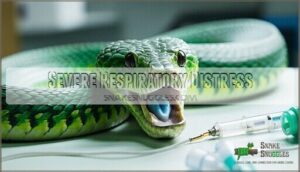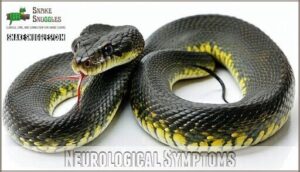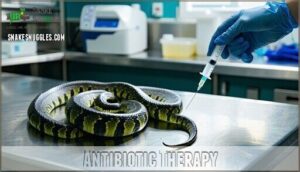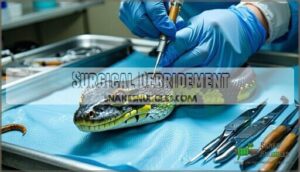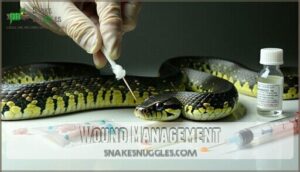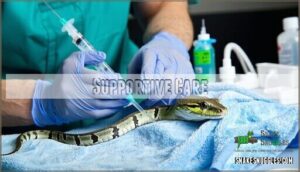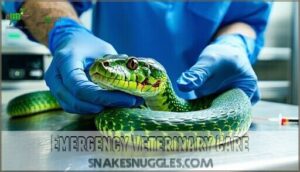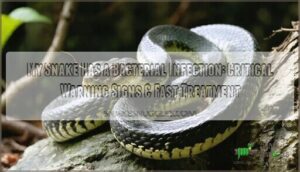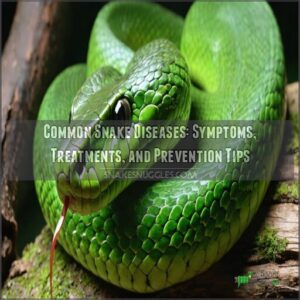This site is supported by our readers. We may earn a commission, at no cost to you, if you purchase through links.
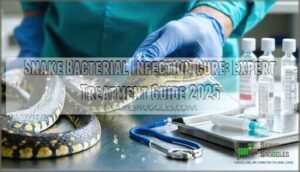 Your snake’s bacterial infection demands immediate veterinary attention—you can’t treat this at home.
Your snake’s bacterial infection demands immediate veterinary attention—you can’t treat this at home.
Veterinarians typically prescribe targeted antibiotics like piperacillin/tazobactam or ciprofloxacin based on culture results.
Treatment involves oral or injectable antibiotics, with severe cases requiring intensive care including fluid therapy and nebulization.
The key is rapid diagnosis and aggressive antibiotic therapy matched to the specific bacteria.
Don’t wait—bacterial infections can quickly escalate to life-threatening septicemia.
Your vet may also recommend surgical debridement for wounds and supportive care to boost your snake’s immune system.
Understanding the warning signs and prevention strategies can save your reptile’s life.
Table Of Contents
- Key Takeaways
- Snake Infection Causes
- Septicemia Symptoms
- Bacterial Infection Treatment
- Preventing Bacterial Infections
- Emergency Veterinary Care
- Frequently Asked Questions (FAQs)
- How to treat bacterial infection in snakes?
- How to cure a bacterial infection quickly?
- Can a bacterial infection be cured on its own?
- What is the best antibiotic for snakes?
- Can bacterial infections spread between different snake species?
- How long do antibiotics take to work?
- Are there natural remedies for snake infections?
- What happens if antibiotics dont work effectively?
- Can snakes develop antibiotic resistance from treatment?
- Conclusion
Key Takeaways
- You can’t treat bacterial infections at home – these require immediate veterinary care with prescription antibiotics like enrofloxacin or ceftazidime, based on culture results.
- Watch for septicemia warning signs – open-mouth breathing, red skin patches, neurological symptoms, and complete appetite loss indicate life-threatening systemic infection requiring emergency intervention.
- Prevention beats treatment – maintain proper humidity (40-60%), temperature gradients (75-85°F), clean enclosures monthly, and reduce stress through adequate hiding spots and minimal handling.
- Act fast when symptoms appear – bacterial infections can progress to organ failure within 24-48 hours, so early veterinary intervention dramatically improves your snake’s survival chances.
Snake Infection Causes
Understanding what causes bacterial infections in your snake is essential for effective treatment and prevention.
These infections typically stem from environmental stress, poor husbandry practices, traumatic injuries, or secondary complications from other health issues, which can be managed with proper care and prevention.
Environmental Stress Factors
Environmental stress wreaks havoc on your snake’s immune system, making bacterial infections inevitable.
Poor Humidity Control creates respiratory issues, while incorrect Temperature Gradients disrupt digestion and immunity.
Contaminated Water Quality introduces harmful bacteria directly into their system. Inadequate Enclosure Size causes chronic stress, and improper Substrate Choice retains moisture and bacteria.
These husbandry issues compound quickly, turning minor environmental stress into life-threatening infections. Maintaining proper humidity can prevent Aspergillus fungi growth, which is crucial for preventing bacterial infections and ensuring the overall health of your snake.
Poor Husbandry Conditions
Your snake’s living conditions directly impact its health, and poor husbandry creates the perfect storm for bacterial infections.
Dirty enclosures become breeding grounds for harmful bacteria, while incorrect temperatures and humidity levels weaken your snake’s immune system. These husbandry issues work together to create environmental stress that makes infections more likely.
Here are the key husbandry factors that lead to snake bacterial infection:
- Enclosure Sanitation – Dirty water bowls, waste buildup, and contaminated surfaces harbor dangerous bacteria
- Temperature Regulation – Incorrect heating creates stress and compromises immune function
- Humidity Control – Poor moisture levels affect respiratory health and skin condition
- Substrate Selection – Dirty or inappropriate bedding materials increase bacterial exposure
- Nutritional Deficiencies – Poor diet weakens natural defenses against infection
Maintaining a clean enclosure with proper environmental controls prevents most bacterial problems before they start.
Traumatic Injuries
Physical trauma opens the door for bacterial invasion in your snake’s body.
Bite wounds from feeding accidents create deep puncture wounds that bacteria love to colonize. Scale damage from rough handling or sharp enclosure edges provides infection risk through broken skin barriers.
Even minor scratches can escalate without proper snake wound care. You’ll need immediate wound cleaning and treatment to prevent traumatic injury complications from developing into systemic infections.
Secondary Infections
Secondary infections often stack up when your snake’s already fighting other health battles.
Mites, parasites, and existing wounds create perfect entry points for bacteria, turning minor issues into serious snake bacterial infections.
- Mite Infestations: These tiny parasite carriers weaken your snake’s skin barrier and introduce harmful bacteria during feeding
- Wound Contamination: Open injuries from handling or cage furniture become bacterial highways into your snake’s system
- Compromised Immunity: Stressed or sick snakes can’t fight off secondary infections, leading to antibiotic resistance concerns
Proper snake wound care and prompt snake infection treatment prevent these cascading health problems.
Septicemia Symptoms
You’ll recognize septicemia in your snake when it starts showing severe, life-threatening symptoms that demand immediate veterinary attention.
This bloodstream infection causes rapid deterioration, with symptoms including respiratory distress, neurological signs, and complete refusal to eat, which are all critical indicators of a serious condition that requires immediate veterinary care.
Severe Respiratory Distress
When your snake shows breathing difficulty, you’re witnessing a medical emergency.
Open-mouth breathing signals severe respiratory distress from snake bacterial infection. Watch for cyanosis signs like bluish discoloration around the mouth.
Snake respiratory infections can progress to aspiration pneumonia rapidly.
Your veterinarian will perform lung auscultation to assess damage.
Oxygen therapy becomes necessary for snake severe respiratory distress cases requiring immediate intervention.
Rapid Deterioration
Within 24-48 hours, snake bacterial infection symptoms can escalate dramatically from mild lethargy to life-threatening septic shock.
Treatment delays directly impact prognosis, with mortality factors increasing exponentially as organ failure progresses.
Your snake’s rapid deterioration signals systemic sepsis requiring immediate veterinary intervention to prevent irreversible damage, which underscores the importance of prompt action to address life-threatening conditions.
Neurological Symptoms
When systemic infection spreads to your snake’s brain and nervous system, you’ll notice seizures, paralysis, and head tilting.
These neurological symptoms indicate severe snake bacterial infection requiring immediate veterinary intervention.
Disorientation and muscle tremors often accompany these snake infection symptoms, signaling dangerous progression of the systemic infection throughout your pet’s body, which can lead to a systemic infection.
Refusal to Eat
Most infected snakes completely lose their appetite, turning their nose up at favorite foods.
You’ll notice this refusal to eat happens early in snake bacterial infection progression. Nutritional deficiency quickly follows, weakening their immune system further.
Your veterinarian might recommend appetite stimulants or force feeding for severe cases. Don’t ignore underlying illnesses or behavioral causes behind eating strikes during snake infections, as these can significantly impact the snake’s ability to recover, making veterinarian guidance crucial.
Bacterial Infection Treatment
When you discover bacterial infections in your snake, immediate treatment becomes critical for survival.
The four main treatment approaches – antibiotic therapy, surgical debridement, wound management, and supportive care – work together to eliminate harmful bacteria and restore your pet’s health.
Antibiotic Therapy
Your veterinarian will prescribe specific snake antibiotics like enrofloxacin, ceftazidime, or amikacin based on culture results.
Proper antibiotic dosage calculation depends on your snake’s weight and species.
Treatment duration typically spans 10-21 days to prevent antibiotic resistance.
Watch for drug interactions with other medications. Alternative antibiotics may be needed if resistance develops during snake bacterial infection treatment.
Surgical Debridement
Surgical debridement becomes necessary when necrotic tissue threatens your snake’s recovery from bacterial infection.
This procedure involves removing dead, infected tissue that can’t heal naturally and may harbor dangerous bacteria.
Essential debridement techniques include:
- Sharp excision – Using scalpel blades for precise tissue removal while preserving healthy areas
- Delayed intervention – Waiting 5-8 days allows clear demarcation between dead and viable tissue
- Repeat procedures – Additional debridement may be required in 28% of severe cases
Anesthesia concerns during snake wound treatment require careful monitoring of respiratory function.
Reptiles can develop ulcerative dermatitis from unhygienic conditions.
Post-op care focuses on preventing complications while supporting tissue regeneration through proper wound debridement protocols.
Wound Management
After treating infected tissue, proper wound care becomes your next priority.
You’ll need to clean wounds daily with chlorhexidine, apply topical antibiotics, and use non-adherent bandages. Systemic antibiotics may also be prescribed for severe infections.
Monitor healing progress closely to prevent complications.
| Wound Care Step | Method | Frequency |
|---|---|---|
| Wound Cleaning | Chlorhexidine solution | Daily |
| Topical Antibiotics | Antibiotic ointment | Twice daily |
| Bandaging Techniques | Non-adherent dressing | Change every 2-3 days |
Supportive Care
You’ll need to provide thorough supportive care alongside wound management to help your snake recover from bacterial infections.
Fluid therapy maintains proper hydration and helps flush toxins from the system. Nutritional support becomes critical when sick snakes refuse food – you might need assisted feeding under veterinary guidance.
Electrolyte balance must be monitored and corrected through IV fluids or oral supplements. Consider using snake electrolyte products to help maintain proper balance.
Stress reduction involves minimizing handling and maintaining quiet environments. This supportive care complements wound cleaning protocols for complete snake bacterial infection cure recovery.
Preventing Bacterial Infections
Prevention is your best defense against bacterial infections in snakes. You’ll save time, money, and stress by addressing the root causes rather than treating infections after they develop.
Correcting Environmental Factors
Creating the right environment is like building a fortress against bacterial invaders. Your snake’s enclosure needs precise conditions to support its immune system and prevent pathogenic growth.
Here’s your environmental control checklist:
- Temperature Regulation: Maintain 75-85°F thermal gradient with proper heating elements
- Humidity Control: Keep levels between 40-60% using digital hygrometers for accuracy
- Enclosure Sanitation: Deep clean monthly with reptile-safe disinfectants to reduce bacterial load
- Water Quality: Provide fresh, clean water daily in sanitized bowls
- Substrate Choice: Use disposable or easily cleaned materials that don’t retain moisture
Proper heating is essential, and consider using a reliable heat source for ideal temperature regulation.
Improving Husbandry Practices
Clean enclosures prevent bacterial growth through proper Enclosure Sanitation and regular substrate changes.
Temperature Regulation maintains immune function, while Humidity Control prevents skin issues.
Choose appropriate Substrate Selection for your species.
Meet Nutritional Needs with balanced diets and clean water.
These husbandry improvements form the foundation of snake health and effective snake disease prevention through thorough snake enclosure maintenance.
Reducing Stress
Stress weakens your snake’s immune system, making bacterial infections more likely. You’ll need to minimize handling, provide adequate hiding spots, and maintain consistent temperatures.
Stressed snakes can’t fight off pathogens effectively, so creating a calm environment is essential for preventing snake bacterial infection.
Stress reduction strategies:
- Enrichment Techniques – Add branches, caves, and varied substrate textures to create natural behaviors and reduce environmental stress
- Handling Methods – Limit contact to essential care only, use slow movements, and support the snake’s body properly during necessary handling
- Quarantine Protocols – Keep new snakes isolated for 30-60 days to prevent disease transmission and allow stress recovery from relocation
- Hiding Spots – Provide multiple secure retreats at different temperature zones so your snake feels protected throughout its enclosure
Social isolation from other snakes prevents territorial stress and disease transmission. Husbandry improvements like proper lighting cycles and stable temperatures create predictable conditions that reduce snake stress and support snake health.
Recognizing early stress symptoms is essential for timely intervention.
Maintaining Clean Enclosures
Within pristine enclosures, bacterial threats diminish dramatically when you establish proper disinfection protocols.
Remove waste daily and perform deep cleaning monthly with reptile-safe disinfectants. Choose appropriate substrate choices that prevent moisture retention.
Maintain water sanitation through regular changes and filtration. Clean enrichment hygiene items weekly to prevent snake bacterial infection.
A clean habitat requires appropriate disinfectant cleaner for reptiles. Your snake’s environment directly impacts enclosure cleanliness and overall snake hygiene.
Emergency Veterinary Care
When your snake shows signs of systemic infection like open-mouth breathing, red patches on the skin, or neurological symptoms, you’re facing a medical emergency that requires immediate veterinary intervention.
These severe symptoms indicate septicemia, a life-threatening condition where bacteria have entered the bloodstream and can lead to organ failure within hours if left untreated, which is a condition that requires immediate veterinary intervention.
Signs of Systemic Infection
During systemic infection, your snake’s entire body becomes a battlefield against bacterial invasion.
Watch for lethargy and weakness as the first red flags – your snake will barely move or respond to handling.
Skin discoloration appears as red patches or blotchy areas, especially on the belly, indicating internal bleeding.
Breathing difficulty manifests as open-mouth breathing or labored respiration, while appetite loss becomes complete food refusal.
Neurological signs like convulsions or abnormal posturing signal sepsis progressing toward organ failure, demanding immediate emergency intervention for organ failure and emergency intervention.
Severe Symptoms
You’ll recognize severe symptoms when your snake shows extreme lethargy, open-mouth breathing, and visible skin hemorrhages.
These red patches signal dangerous blood poisoning affecting essential organs.
Convulsions may occur as snake septicemia progresses, indicating neurological involvement.
Snake sepsis causes organ failure rapidly, making immediate veterinary intervention necessary to prevent death from this systemic infection.
Rapid Decline
During the throes of bacterial septicemia, your snake’s condition can deteriorate within hours, transforming from mild illness to life-threatening emergency.
This rapid decline demands immediate recognition and swift veterinary intervention to prevent irreversible organ damage.
- Sudden Weakness – Your snake becomes limp, unable to support its body weight
- Appetite Loss – Complete refusal to eat, even favorite foods
- Breathing Difficulty – Labored, open-mouth breathing indicating respiratory distress
- Organ Failure – Multiple systems begin shutting down simultaneously
- Immediate Action – Every minute counts before septicemia becomes irreversible
Neurological Signs
Something’s definitely wrong when your snake starts showing seizures, head tilting, muscle tremors, disorientation, or paralysis.
These neurological symptoms signal that a snake bacterial infection has reached septicemia – a life-threatening emergency requiring immediate snake veterinary care.
| Neurological Sign | What You’ll See | Urgency Level |
|---|---|---|
| Seizures | Uncontrolled convulsions | Critical |
| Head Tilting | Abnormal head positioning | High |
| Muscle Tremors | Involuntary shaking | High |
These snake neurological symptoms and snake disease symptoms mean bacteria have invaded your pet’s nervous system.
Neurological abnormalities such as star-gazing behavior can also indicate serious issues.
Frequently Asked Questions (FAQs)
How to treat bacterial infection in snakes?
Bacterial infections affect 32% of snakebite cases in Asia.
You’ll need immediate veterinary care for proper diagnosis and antibiotic treatment.
Clean the enclosure thoroughly, fix humidity and temperature issues, and complete the full prescribed antibiotic course to prevent resistance.
How to cure a bacterial infection quickly?
Quick bacterial infection treatment requires immediate veterinary care for proper antibiotic selection, thorough enclosure disinfection, correcting environmental factors like temperature and humidity, and completing the full prescribed treatment course consistently.
Can a bacterial infection be cured on its own?
While hope springs eternal, bacterial infections rarely resolve without treatment.
You’ll need antibiotics to effectively clear the infection and prevent complications.
Your immune system alone typically can’t eliminate established bacterial infections, and thus treatment is necessary.
What is the best antibiotic for snakes?
You’ll need veterinary-prescribed antibiotics like fluoroquinolones or aminoglycosides for systemic infections. For topical treatment, use prescribed antibiotic creams. Don’t attempt self-treatment—bacterial infections require professional diagnosis and species-specific dosing.
Can bacterial infections spread between different snake species?
Yes, bacterial infections can spread between different snake species through direct contact, shared equipment, contaminated environments, or handling.
You’ll need to quarantine infected snakes immediately and thoroughly disinfect all shared surfaces and tools, which includes taking steps to prevent further spread by addressing contaminated environments.
How long do antibiotics take to work?
Antibiotics typically start working within 24-48 hours for your snake’s bacterial infection. You’ll notice improvements in appetite and activity levels first, though complete healing takes 7-10 days with consistent treatment.
Are there natural remedies for snake infections?
Unfortunately, natural remedies are absolutely useless against serious bacterial infections in snakes.
You’ll need veterinary-prescribed antibiotics for effective treatment.
Home remedies can’t combat systemic infections and may delay critical care, potentially worsening your snake’s condition, which is why they are absolutely useless.
What happens if antibiotics dont work effectively?
When antibiotics fail, you’ll need bacterial culture testing to identify resistant strains.
Your vet may switch to different antibiotics, perform surgical debridement, or provide intensive supportive care including fluid therapy and hospitalization.
Can snakes develop antibiotic resistance from treatment?
Bacterial strains can develop resistance when you don’t complete the full antibiotic course or use inappropriate medications.
Your snake’s infections become harder to treat if resistance develops, requiring stronger antibiotics and extended treatment periods.
Conclusion
Bacterial infections can transform your healthy snake into a critically ill reptile within hours, making swift action absolutely vital.
Remember that effective snake bacterial infection cure requires professional veterinary intervention—home remedies simply won’t cut it against serious bacterial pathogens.
Your veterinarian will prescribe targeted antibiotics based on culture results, potentially saving your snake’s life.
Don’t delay when you notice symptoms like respiratory distress or lethargy, as early treatment dramatically improves outcomes and prevents progression to life-threatening septicemia.
- https://www.petmd.com/reptile/conditions/mouth/snake-mouth-rot-symptoms-causes-and-treatment
- https://vcahospitals.com/know-your-pet/snakes-diseases
- https://pmc.ncbi.nlm.nih.gov/articles/PMC5070184/
- https://www.vetlexicon.com/exotis/reptiles/dermatology/articles/bacterial-dermatitis/
- https://reptilesmagazine.com/reptile-medications/

